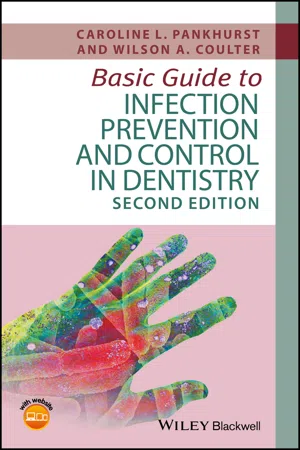
Basic Guide to Infection Prevention and Control in Dentistry
- English
- ePUB (mobile friendly)
- Available on iOS & Android
Basic Guide to Infection Prevention and Control in Dentistry
About This Book
Basic Guide to INFECTION PREVENTION AND CONTROL IN DENTISTRY
A practical step-by-step guide for all members of the dental team
Thoroughly updated, this new edition ensures all members of the dental team are up to speed on the practical aspects of infection prevention and control. It provides step-by-step guidance on the safe running of a dental practice, clear and concise explanations of the key issues and concepts, an overview of the evidence base, and coverage of legal and regulatory issues about which all staff members need to be aware. With more colour photographs and illustrations than the first edition, it also includes appendices full of useful practical and clinical information, and a companion website offering helpful instructional videos and self-assessment questions.
Key topics include communicable diseases, occupational health and immunization, sharp safe working, hand hygiene, personal protective equipment, disinfection of dental instruments, surface decontamination, dental unit waterlines, clinical waste management, and pathological specimen handling.
An indispensable working resource for the busy dental practice, Basic Guide to Infection Prevention and Control in Dentistry, 2nd Edition is also an excellent primer for dental students.
Frequently asked questions
Information
Chapter 1
Essentials of infection control
WHY DO WE NEED INFECTION CONTROL IN DENTISTRY?

RELATIVE RISK AND RISK PERCEPTION
- Potential for actual injury to patients or staff
- Significant occupational health and safety hazard
- The possibility of erosion of reputation or public confidence
- Potential for litigation
- Minor incidents which occur in clusters and may represent trends
RISK ASSESSMENT AND THE MANAGEMENT DECISION‐MAKING PROCESS
Box 1.1 Summary of standard infection control precautions
- Use of hand hygiene
- Use of gloves
- Use of facial protection (surgical masks, visors or goggles)
- Use of disposable aprons/gowns
- Prevention and management of needlestick and sharps injuries and splash incidents
- Use of respiratory hygiene and cough etiquette
- Management of used surgical drapes and uniforms
- Ensure safe waste management
- Safe handling and decontamination of dental instruments and equipment
- Strives for the optimal balance of risk by focusing on the reduction or mitigation of risk while supporting and fostering innovation, so that greatest returns can be achieved with acceptable results, costs and risks.
- Supports better decision making through a solid understanding of all risks and their likely impact.
- Enables dentists to plan for uncertainty, with well‐considered contingency plans which cope with the impact of unexpected events and increase staff, patient and pub...
Table of contents
- Cover
- Title Page
- Table of Contents
- Foreword
- Preface
- Acknowledgements
- About the companion website
- Chapter 1: Essentials of infection control
- Chapter 2: Communicable diseases in the dental surgery
- Chapter 3: Occupational health and immunization
- Chapter 4: Sharp safe working in the dental surgery
- Chapter 5: Hand hygiene
- Chapter 6: Personal protection for prevention of cross-infection
- Chapter 7: Sterilization and disinfection of dental instruments
- Chapter 8: Dental surgery design, surface decontamination and managing aerosols
- Chapter 9: Management of dental unit waterlines
- Chapter 10: Healthcare waste management
- Chapter 11: Transport and postage of diagnostic specimens, impressions and equipment for servicing and repair
- Appendix
- Index
- End User License Agreement